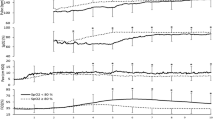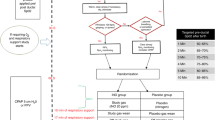Abstract
Objective:
To compare the rate of increase in oxygen saturation in babies receiving supplemental oxygen during resuscitation with those transitioning in room air.
Study Design:
Prospective observational study. Infants were resuscitated with supplemental oxygen and continuous recording of preductal oxygen saturation was started immediately after birth. Oxygen saturation measurements from healthy newborns transitioned in room air were used for comparison.
Result:
A total of 186 infants were included—70 received supplemental oxygen and 116 were transitioned in room air. Compared with healthy infants transitioned in room air, infants receiving 100% oxygen by positive-pressure ventilation (PPV) did not differ significantly in the rate of increase in oxygen saturation (1.5% per minute, P=0.26), whereas infants receiving 100% free-flow oxygen had a significantly slower rate of increase in oxygen saturation (1.2% per minute, P=0.04).
Conclusion:
Babies receiving 100% oxygen by free flow had a slower increase in oxygen saturation compared with healthy infants transitioned in room air, whereas those receiving 100% oxygen by PPV had a similar increase in oxygen saturation compared with healthy infants transitioned in room air.
This is a preview of subscription content, access via your institution
Access options
Subscribe to this journal
Receive 12 print issues and online access
$259.00 per year
only $21.58 per issue
Buy this article
- Purchase on Springer Link
- Instant access to full article PDF
Prices may be subject to local taxes which are calculated during checkout


Similar content being viewed by others
References
Dimich I, Singh PP, Adell A, Hendler M, Sonnenklar N, Jhaveri M . Evaluation of oxygen saturation monitoring by pulse oximetry in neonates in the delivery system. Can J Anaesth 1991; 38: 985–988.
Gonzales GF, Salirrosas A . Pulse oxygen saturation and neurologic assessment in human neonates after vaginal and cesarean delivery. Int J Gynaecol Obstet 1998; 63: 63–66.
Kopotic RJ, Lindner W . Assessing high-risk infants in the delivery room with pulse oximetry. Anesth Analg 2002; 94: S31–S36.
Deckardt R, Schneider KT, Graeff H . Monitoring arterial oxygen saturation in the neonate. J Perinat Med 1987; 15: 357–360.
Rabi Y, Yee W, Chen SY, Singhal N . Oxygen saturation trends immediately after birth. J Pediatr 2006; 148: 590–594.
Harris AP, Sendak MJ, Donham RT . Changes in arterial oxygen saturation immediately after birth in the human neonate. J Pediatr 1986; 109: 117–119.
House JT, Schultetus RR, Gravenstein N . Continuous neonatal evaluation in the delivery room by pulse oximetry. J Clin Monit 1987; 3: 96–100.
Porter KB . Evaluation of arterial oxygen saturation of the newborn in the labor and delivery suite. J Perinatol 1987; 7: 337–339.
Kamlin CO, O’Donnell CP, Davis PG, Morley CJ . Oxygen saturation in healthy infants immediately after birth. J Pediatr 2006; 148: 585–589.
Michna J, Jobe AH, Ikegami M . Positive end-expiratory pressure preserves surfactant function in preterm lambs. Am J Respir Crit Care Med 1999; 160: 634–639.
Poets CF, Rau GA, Neuber K, Gappa M, Seidenberg J . Determinants of lung volume in spontaneously breathing preterm infants. Am J Respir Crit Care Med 1997; 155: 649–653.
Probyn ME, Hooper SB, Dargaville PA, McCallion N, Crossley K, Harding R et al. Positive end expiratory pressure during resuscitation of premature lambs rapidly improves blood gases without adversely affecting arterial pressure. Pediatr Res 2004; 56: 198–204.
Schlessel JS, Susskind H, Joel DD, Bossuyt A, Harrold WH, Zanzi I et al. Effect of PEEP on regional ventilation and perfusion in the mechanically ventilated preterm lamb. J Nucl Med 1989; 30: 1342–1350.
Boon AW, Milner AD, Hopkin IE . Lung expansion, tidal exchange, and formation of the functional residual capacity during resuscitation of asphyxiated neonates. J Pediatr 1979; 95: 1031–1036.
Hammon Jr JW, Wolfe WG, Moran JF, Jones RH, Sabiston Jr DC . The effect of positive end-expiratory pressure on regional ventilation and perfusion in the normal and injured primate lung. J Thorac Cardiovasc Surg 1976; 72: 680–689.
Saunders RA, Milner AD, Hopkin IE . The effects of continuous positive airway pressure on lung mechanics and lung volumes in the neonate. Biol Neonate 1976; 29: 178–186.
Vyas H, Milner AD, Hopkin IE, Boon AW . Physiologic responses to prolonged and slow-rise inflation in the resuscitation of the asphyxiated newborn infant 1. J Pediatr 1981; 99: 635–639.
Saugstad OD . Optimal oxygenation at birth and in the neonatal period. Neonatology 2007; 91: 319–322.
AHA-AAP Neonatal Resuscitation Program Steering Committee. Textbook of Neonatal Resuscitation. 4th ed. American Academy of Pediatrics: Elk Grove Village, USA, 2000.
Cohen J, West SG, Cohen P, Aiken L . Applied Multiple Regression/Correlation Analysis for the Behavioral Sciences. 3rd edn Lawrence Erlbaum Assoc Inc., Mahwah, New Jersey, 2002.
Littell RC, Milliken GA, Stroup WW, Wolfinger RD, Schabenberger O . SAS for Mixed Models. 2nd edn SAS Publishing, Cary, North Carolina, 1996.
Thome U, Topfer A, Schaller P, Pohlandt F . The effect of positive endexpiratory pressure, peak inspiratory pressure, and inspiratory time on functional residual capacity in mechanically ventilated preterm infants. Eur J Pediatr 1998; 157: 831–837.
Leone TA, Rich W, Finer NN . A survey of delivery room resuscitation practices in the United States. Pediatrics 2006; 117: e164–e175.
Saugstad OD, Ramji S, Rootwelt T, Vento M . Response to resuscitation of the newborn: early prognostic variables. Acta Paediatrica 2005; 94: 890–895.
Author information
Authors and Affiliations
Corresponding author
Additional information
Financial Disclosure
None.
Conflict of interest
None declared. All authors contributed to all sections of the first draft of the manuscript and all subsequent revisions.
Rights and permissions
About this article
Cite this article
Rabi, Y., Chen, S., Yee, W. et al. Relationship between oxygen saturation and the mode of oxygen delivery used in newborn resuscitation. J Perinatol 29, 101–105 (2009). https://doi.org/10.1038/jp.2008.186
Received:
Revised:
Accepted:
Published:
Issue Date:
DOI: https://doi.org/10.1038/jp.2008.186



